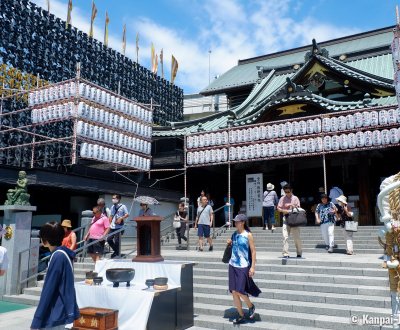Naritasan Fukagawa Fudo-do
Koto’s Modern Esoteric Temple
Naritasan Fukagawa Fudo-do is a Buddhist temple of the Shingon esoteric school, located in Koto ward, in the east of Tokyo down-town. Every day, the temple’s monks perform impressive rituals dedicated to Fudo Myoo, one of the 5 Kings of Wisdom.
Naritasan Fukagawa Fudo-do belongs to the Shingon Buddhism esoteric school, founded in Japan in the 9th century by monk Kukai (Kobo Daishi). It is also affiliated to Narita-san Shinsho-ji, a temple located near Narita International Airport in the east of Tokyo.
Built in 1703, the temple is damaged by the Great Kanto Earthquake in 1923, then by 1945’s aerial bombings. It is thereafter reconstructed in a surprising mix of ancient and modern styles:
- The entrance’s finely ornamented wooden part dates back to 1862 and was installed here during the renovation;
- The original main pavilion is considered as the oldest spiritual wooden structure in Koto ward;
- The current main pavilion, built in front of the former one, displays a contemporary architecture with tall white walls covered in metallic Sanskrit letters (India’s classical language).
In the outer enclosure, you’ll also find the usual traditional ema votive plates displayed next to a small charming Inari shrine.
Inside the temple stands an impressive wooden statue of Fudo Myoo, the main worshiping image of Naritasan Fukagawa Fudo-do. One of the 5 Kings of Wisdom, he represents the immutable, and is pictured in a wrathful appearance to ward off demons and other creatures of the nether worlds.

Daily Goma fire ceremonies
Visitors of the temple can attend every day to several Goma fire 🔥 ceremonies, a ritual of purification by fire in honor of Fudo Myoo. Here the sacred fire symbolizes Buddha’s wisdom, and the flames that devour all human desires, which are sources of suffering and negative thoughts and prevent from advancing further on the path to the Enlightenment.
The start of the ceremony is announced by a typical sound, made when monks blow into large shellfish. Then, while the taiko drum resonates, wishes that attendees have previously written on wooden plates, are read aloud and are thrown into the fire to burn. The underlying idea is that one can break away from this wish to reach a kind of wisdom. Anyone can buy a plate at the temple and write wishes, that are usually in connection to the family, health, work or academic success. Sutra Buddhist prayers are also chanted by choirs of monks.
Before the Covid 🦠 crisis, at the end of the ritual, attendees were invited to purify their purse or handbag into the fire. Rather than an act of blessing and protection, it is more a way of breaking away from all material attachments and to move to the path of detachment, the way to salvation in Buddhism. Most of the times, the ceremony ends with the announcement of the next important events at the temple.

After this quite impressive spiritual experience, visitors enjoy the return to calm and strolling through the rooms to admire, among others:
- Several statues of Fudo Myoo, including one carved in a more than 500 year-old camphor tree;
- A gallery displaying about 10,000 small crystal gorinto pagoda;
- A ceiling painting by contemporary artist Chinami Nakajima that pictures Dainichi Nyorai, the central Buddha of the Shingon school; and,
- A room themed on Shikoku’s 88 temples Pilgrimage and Kobo Daishi.
Modern and lively all year round, Naritasan Fukagawa Fudo-do temple also hosts the summer matsuri festival of neighboring Tomioka Hachiman-gu great shrine.

